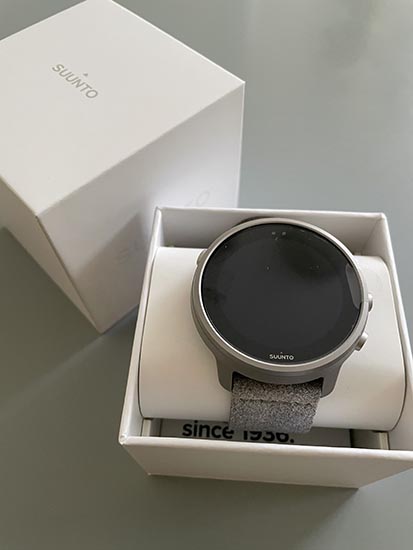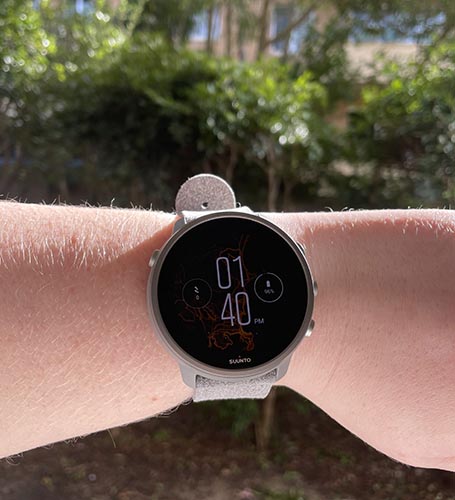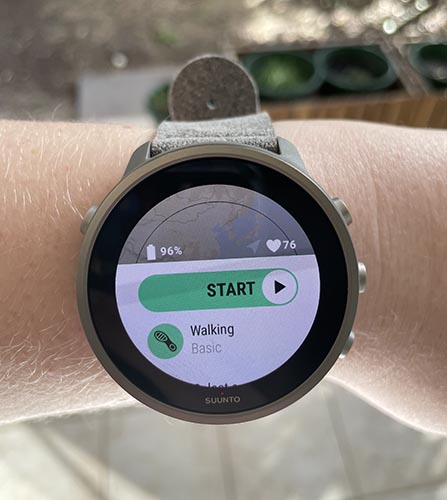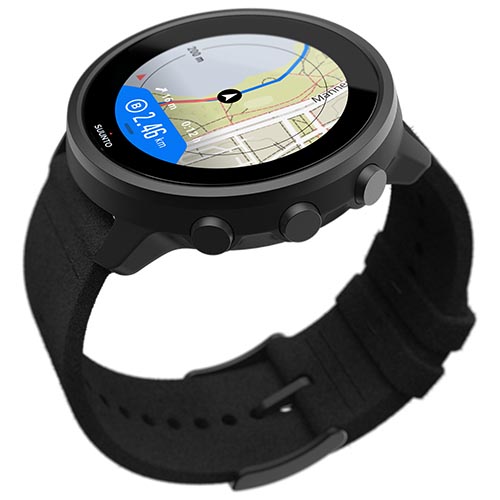While the name Suunto might not be the most recognisable in the world of smartwatches and fitness trackers, this Finnish brand has a long history in making products and technology for the outdoors, and its range of fitness watches reflect this background.
The Suunto 7 Titanium is one of the latest sports watches to be released by the manufacturer. Suunto’s devices are much more of a fitness watch than a smartwatch. These devices are designed for the more active person who wants a wearable that can keep up and track their activity and exercise, rather than being an extension of your smartphone.
With that in mind, there’s no doubt that the Suunto 7 is for the more sporty user than someone looking for the basics in a fitness tracker, thanks to its huge range of activities and tracking tools. If you’re curious about the sort of features and performance you get from this fitness-focused watch, read on for our review on the Suunto 7 Titanium to find out if this is the right smartwatch for you.
Suunto 7 Titanium features and specs
Here’s a quick look at some of the features and specs available with the Suunto 7 Titanium:
- $699 AUD RRP (available from retailers including Harvey Norman, Myer and specialist stores)
- Titanium Grade 5 bezel
- Gorilla glass
- Microfibre textile strap included
- Google Watch OS integration
- GPS tracking, weather tracking, sleep tracking
- 70+ sports modes included
- Two colour options — Matte Black Titanium and Stone Grey Titanium
Pros:
- Huge selection of sports modes
- Quick charging
- Rather simple and seamless to use
- Suunto app provides good detail on activities and performance
Cons:
- Battery life not great
- Tends to disconnect from smartphone quite frequently
- Over reliance on smartphone apps for some functions
- A bit bulky to wear
Design, appearance and wearability
Perhaps one of the most important things about a smartwatch (or fitness watch) is the look and feel of the device. After all, if you’re going to wear it almost every day, it needs to look good and feel comfortable.
The Suunto 7 Titanium is a nice looking watch — in the box it looks clean and simple, but stylish. I was given the Stone Grey Titanium and it looked really nice, and I especially liked that the watch’s outer casing is a similar colour to the included fabric wristband. As for the size, it is a bit big on the wrist, but that’s the compromise you make for a large and easy to read screen. While it felt bulky to start with, I found that I got used to the size quite quickly, and it became comfortable to wear every day. However, when doing certain exercises, the bulkiness could sometimes get in the way, and you need to ensure it’s far enough up your wrist to not impact your hand and wrist movements. The soft microfibre textile strap is also comfortable to wear and has a suede-like finish.
The screen is nice and bright and you have the option for a few different watch faces, including one that uses GPS to display the map of the area where you are. Navigating the device is fairly simple, with four side buttons and swipe gestures used for navigating to different sections and functions. You can choose to enable or disable the tilt to wake and touch to wake functions, and navigation is reasonably straightforward. I did find at times it was hard to track down certain settings, and I had to rely on user guides to find certain features and functions. At times these features or settings needed the phone apps rather than the device itself, which was a little frustrating.
Overall, it’s a comfortable watch and looks really sleek. It’s neutral enough to suit what you wear day-to-day and feels sturdy enough to cope with an active lifestyle. The screen size is large enough to display what you need it to, but with that larger screen comes the compromise of size, and it is a rather chunky watch. Some users might find it a bit too large, but I found it was easy to get used to.
Performance, battery and functionality
Considering the Suunto 7 is at a higher price range, you’d expect a high quality performance, and it certainly does deliver. It’s quick to respond, the tracking — both GPS and health tracking — is accurate and seamless, and overall, it delivers a good performance that’s easy to get the hang of and to navigate.
However, the biggest let-down for the Suunto 7 is the battery life. That constant tracking, and with GPS enabled, clearly needs a lot of power for that quality performance. However the trade-off for great GPS is limited day-long battery life, as the more the watch has to ‘work’, the quicker the battery drains.

Some days with minimal moving around, and therefore minimal tracking, I found the watch could easily last the full day, even with around an hour of exercise tracking, and still have 20% or so battery remaining. However, some days, particularly a full day of wear, it just couldn’t keep up — one day in particular it was around 95% battery when I put the watch on at 7am, and it didn’t quite last into the night as the battery died sometime before 9:30pm.
The inconsistency of battery drain to me makes the Suunto 7 feel like it’s not the most reliable day-to-day watch. However the one positive is that it is super quick to charge, from 0% to 100% in just over an hour (around an hour and 10 minutes). The included USB charger is quite small and easy to carry around and if you have the ability to, a quick charge during the day can keep you going longer. One thing to note is that I opted to use the watch face that shows a map of the area you’re in using GPS, so choosing a different watch face can impact the battery drain. Suunto does have some ‘maximise battery life’ suggestions, which — while useful — does indicate that battery drain for the Suunto 7 is a known problem.
Another issue I had was the watch’s connectivity to my phone, usually after a period of inactivity, like putting the watch on first thing in the morning. It didn’t always automatically connect, and sometimes I would need to open the Watch OS app to re-establish a connection. I also found syncing the watch to the Suunto app to look at your day’s activities was, at times, slow to manually connect and sync up. However, when your watch and phone is connected, it’s very quick at updating your activities.
One other small functional issue I had was when you’re playing music or video on your phone, the watch display automatically goes to the ‘what’s playing’ screen. When I was using an instructional exercise video on YouTube, I found myself often accidentally skipping the video as I’d go to touch the screen to start my exercise tracking. It might not bother some people but for me, I found it a slightly frustrating attempt at convenience. However, some people might find this a useful feature, so I feel it’s more of a personal preference.
The GPS tracking is one of the strengths of the Suunto 7 due to the detail, and you can easily access maps on the watch. I particularly like that when you’re looking at the map, you can zoom in and out, and there is a little line indicating distance. It’s a small feature but great for that day-to-day use, especially if you have your phone stashed in your bag.
All that being said, the general performance and functionality of the Suunto 7 was great. As a day-to-day watch, it is really easy to get used to, and the in-depth tracking of your heart rate, weekly exercise progress, steps, calories, etc. is really fluid to navigate and provides good detail. It also syncs with notifications on your phone (which you can turn off), and being able to access what music or video your phone is playing is quite useful, so it integrates quite nicely into your day.
Exercise features and performance tracking
As the Suunto 7 is primarily a sports watch, you can expect a huge range of exercise modes and performance tracking tools included. This watch is aimed at more serious fitness enthusiasts, especially considering the price point. For more casual fitness users, this watch probably offers more tools than you would typically need, so it might not be really worth the price.
There are over 70 sports modes available and if you’re struggling to list that many sports off the top of your head, there are some additions that are a little left of field. Modes are separated into categories: Running, Cycling, Performance, Indoor Sports, Outdoor Adventures, Winter Sports, Water Sports, Team and Racket Sports and Unspecified. Under those categories you’ll find activities such as running (race), treadmill, indoor cycling, mountain biking, cycling (commuting), cross training, roller skating, weight training, stretching, yoga/Pilates, cross-trainer, aerobics, walking, horseback riding, mountain climbing, snowboarding, surfing, pool swimming, kayaking, tennis, rugby, cricket, golf, plus some more unusual activities such as floorball, cheerleading, frisbee, snowshoeing, Nordic walking and paragliding.

From that list, it’s clear that this watch is really suited to people who enjoy a wide range of activities and really like to measure performance. For an average user, you’ll get the basic information you’ll want like heart rate, duration, calories, steps, etc. However, some activities will go into wider detail, which is great for anyone looking to monitor specific elements of their activity.
For example, when tracking regular outdoor walking, you’ll get details like time, distance, heart rate, calories and steps, however you’ll also get ascent, descent, altitude, cadence, pace and auto laps. Yoga/Pilates will just give basics like duration, heart rate and calories. When you’re in the activity mode, the type of activity you’re doing will determine which statistics you’re being shown, however you can also create custom sports modes and choose which information you want to see on screen during the activity. Pausing, resuming and stopping the activity is easy thanks to the use of the side buttons.
I really enjoyed how detailed the exercise tracking was, and when you sync your watch with the Suunto phone app, you can look at the information afterwards and track your daily performance inclusive of exercises. To use the Suunto 7 to its best extent, you do need to use the Suunto app. During my time with the Suunto 7, there were a couple of app updates which included some more information and tracking features, so you know that Suunto is putting effort into creating a great supporting app for users.
The GPS tracking gives you a detailed map of where you were walking when you track it as exercise, and even includes details like the temperature at the time of the activity. You can also set a route with turn-by-turn navigation, and find suggested routes for certain activities in your area, like trail running and cycling, with information such as distance, duration and ascent. These are great features for the more outdoorsy adventurer who likes to find new places to explore, all while keeping you on track.
Another plus is that you can lock the screen as you exercise, minimising the potential for bumping or accidentally pausing activity. However the bulkiness of the watch might get in the way of certain activities. I found I had to ensure the watch was a bit further up my arm to allow me to maintain flexibility in my wrist/hand when doing yoga and stretching. Although this is an issue with other bulky smartwatches and fitness watches, you adjust to it rather easily.
The Suunto 7 also includes sleep tracking but this is one feature I didn’t utilise. However, if you’re comfortable wearing a watch to bed and do want to track your sleep, it’s good to have as an option.
Overall, the Suunto 7 does boast a very impressive set of tools not just for tracking different exercises, but also for your wider fitness performance. There is plenty of detail and anyone who enjoys a wide range of activities, or does a lot of outdoor sports like hiking and cycling, will find some great features with this watch.

Suunto 7: verdict
While my personal fitness regime is limited to a small range of activities, I can see how more adventurous people or those who enjoy a very wide range of activities, will really benefit from the Suunto 7. For day-to-day use and exercise tracking it does a great job, but for the price point, you’d want to ensure you are the sort of user that this watch is aimed at.
The detailed information is great and I can see how it would benefit more serious athletes or exercise enthusiasts. For a more average user though, the price point is quite steep, and you’d be better off going for a cheaper and more basic fitness watch.
All of the benefits of the features, performance and tracking is somewhat let down by the inconsistent battery life. There are various settings and adjustments you can make to maximise your battery life, including battery saver mode, however if you were out for a full day doing activities that require battery (especially GPS) it might not last you the full day.
Overall, the Suunto 7 Titanium does a really good job at what you would expect from a fitness watch. The sheer number of sports modes is great, and the in-depth performance tracking and features are what you’d want in a sports watch of this level. The price point is definitely a bit steep for an average user, but for more serious sports and fitness enthusiasts who can afford a more premium fitness watch, it might be worth considering.
Looking for a new mobile phone?
Of course, sports watches typically need to be paired with a smartphone. If you’ve been looking to upgrade to a new mobile phone, the following tables include the latest popular devices from Apple and Samsung. Switch between the tabs to view phone plans for each device.
The following table shows a selection of 24-month 128GB Apple iPhone 13 Pro plans on Canstar Blue’s database, listed in order of standard cost, from the lowest to highest and then by data allowance, largest to smallest. Use our comparison tool to see plans from a wide range of telco providers. This is a selection of products with links to referral partners.
The following table shows a selection of 24-month 128GB Samsung Galaxy S21+ plans on Canstar Blue’s database, listed in order of standard monthly cost, from the lowest to highest and then by data allowance, largest to smallest. Use our comparison tool to see plans from a range of other providers. This is a selection of products which may contain links to a referral partner.
Product used for review/testing was a free sample provided by Suunto.


Share this article